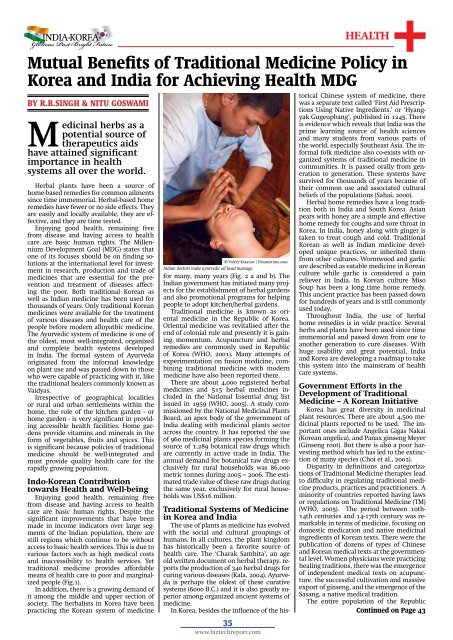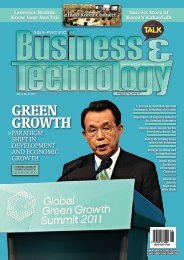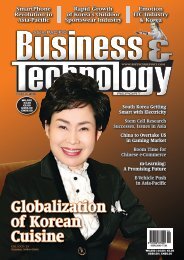INDIA-KOREA - Asia-Pacific Business and Technology Report
INDIA-KOREA - Asia-Pacific Business and Technology Report
INDIA-KOREA - Asia-Pacific Business and Technology Report
You also want an ePaper? Increase the reach of your titles
YUMPU automatically turns print PDFs into web optimized ePapers that Google loves.
health<br />
<strong>INDIA</strong>-<strong>KOREA</strong><br />
Glorious Past Bright Future<br />
Mutual Benefits of Traditional Medicine Policy in<br />
Korea <strong>and</strong> India for Achieving Health MDG<br />
by R.B.Singh & Nitu Goswami<br />
Medicinal herbs as a<br />
potential source of<br />
therapeutics aids<br />
have attained significant<br />
importance in health<br />
systems all over the world.<br />
Herbal plants have been a source of<br />
home-based remedies for common ailments<br />
since time immemorial. Herbal-based home<br />
remedies have fewer or no side effects. They<br />
are easily <strong>and</strong> locally available, they are effective,<br />
<strong>and</strong> they are time tested.<br />
Enjoying good health, remaining free<br />
from disease <strong>and</strong> having access to health<br />
care are basic human rights. The Millennium<br />
Development Goal (MDG) states that<br />
one of its focuses should be on finding solutions<br />
at the international level for investment<br />
in research, production <strong>and</strong> trade of<br />
medicines that are essential for the prevention<br />
<strong>and</strong> treatment of diseases affecting<br />
the poor. Both traditional Korean as<br />
well as Indian medicine has been used for<br />
thous<strong>and</strong>s of years. Only traditional Korean<br />
medicines were available for the treatment<br />
of various diseases <strong>and</strong> health care of the<br />
people before modern allopathic medicine.<br />
The Ayurvedic system of medicine is one of<br />
the oldest, most well-integrated, organized<br />
<strong>and</strong> complete health systems developed<br />
in India. The formal system of Ayurveda<br />
originated from the informal knowledge<br />
on plant use <strong>and</strong> was passed down to those<br />
who were capable of practicing with it, like<br />
the traditional healers commonly known as<br />
Vaidyas.<br />
Irrespective of geographical localities<br />
or rural <strong>and</strong> urban settlements within the<br />
home, the role of the kitchen garden - or<br />
home garden - is very significant in providing<br />
accessible health facilities. Home gardens<br />
provide vitamins <strong>and</strong> minerals in the<br />
form of vegetables, fruits <strong>and</strong> spices. This<br />
is significant because policies of traditional<br />
medicine should be well-integrated <strong>and</strong><br />
must provide quality health care for the<br />
rapidly growing population.<br />
Indo-Korean Contribution<br />
towards Health <strong>and</strong> Well-being<br />
Enjoying good health, remaining free<br />
from disease <strong>and</strong> having access to health<br />
care are basic human rights. Despite the<br />
significant improvements that have been<br />
made in income indicators over large segments<br />
of the Indian population, there are<br />
still regions which continue to be without<br />
access to basic health services. This is due to<br />
various factors such as high medical costs<br />
<strong>and</strong> inaccessibility to health services. Yet<br />
traditional medicine provides affordable<br />
means of health care to poor <strong>and</strong> marginalized<br />
people (Fig.1).<br />
In addition, there is a growing dem<strong>and</strong> of<br />
it among the middle <strong>and</strong> upper section of<br />
society. The herbalists in Korea have been<br />
practicing the Korean system of medicine<br />
Indian doctors make ayurvedic oil head massage.<br />
© Valery Kraynov | Dreamstime.com<br />
for many, many years (Fig. 2 a <strong>and</strong> b). The<br />
Indian government has initiated many projects<br />
for the establishment of herbal gardens<br />
<strong>and</strong> also promotional programs for helping<br />
people to adopt kitchen/herbal gardens.<br />
Traditional medicine is known as oriental<br />
medicine in the Republic of Korea.<br />
Oriental medicine was revitalised after the<br />
end of colonial rule <strong>and</strong> presently it is gaining<br />
momentum. Acupuncture <strong>and</strong> herbal<br />
remedies are commonly used in Republic<br />
of Korea (WHO, 2001). Many attempts of<br />
experimentation on fusion medicine, combining<br />
traditional medicine with modern<br />
medicine have also been reported there.<br />
There are about 4,000 registered herbal<br />
medicines <strong>and</strong> 515 herbal medicines included<br />
in the National Essential drug list<br />
issued in 1959 (WHO, 2005). A study commissioned<br />
by the National Medicinal Plants<br />
Board, an apex body of the government of<br />
India dealing with medicinal plants sector<br />
across the country. It has reported the use<br />
of 960 medicinal plants species forming the<br />
source of 1,289 botanical raw drugs which<br />
are currently in active trade in India. The<br />
annual dem<strong>and</strong> for botanical raw drugs exclusively<br />
for rural households was 86,000<br />
metric tonnes during 2005 – 2006. The estimated<br />
trade value of these raw drugs during<br />
the same year, exclusively for rural households<br />
was US$16 million.<br />
Traditional Systems of Medicine<br />
in Korea <strong>and</strong> India<br />
The use of plants as medicine has evolved<br />
with the social <strong>and</strong> cultural groupings of<br />
humans. In all cultures, the plant kingdom<br />
has historically been a favorite source of<br />
health care. The ‘Charak Samhita’, an age<br />
old written document on herbal therapy, reports<br />
the production of 340 herbal drugs for<br />
curing various diseases (Kala, 2004). Ayurveda<br />
is perhaps the oldest of these curative<br />
systems (6000 B.C.) <strong>and</strong> it is also greatly superior<br />
among organized ancient systems of<br />
medicine.<br />
In Korea, besides the influence of the his-<br />
35<br />
www.biztechreport.com<br />
torical Chinese system of medicine, there<br />
was a separate text called ‘First Aid Prescriptions<br />
Using Native Ingredients,’ or ‘Hyangyak<br />
Gugeupbang’, published in 1245. There<br />
is evidence which reveals that India was the<br />
prime learning source of health sciences<br />
<strong>and</strong> many students from various parts of<br />
the world, especially Southeast <strong>Asia</strong>. The informal<br />
folk medicine also co-exists with organized<br />
systems of traditional medicine in<br />
communities. It is passed orally from generation<br />
to generation. These systems have<br />
survived for thous<strong>and</strong>s of years because of<br />
their common use <strong>and</strong> associated cultural<br />
beliefs of the populations (Sahai, 2000).<br />
Herbal home remedies have a long tradition<br />
both in India <strong>and</strong> South Korea. <strong>Asia</strong>n<br />
pears with honey are a simple <strong>and</strong> effective<br />
home remedy for coughs <strong>and</strong> sore throat in<br />
Korea. In India, honey along with ginger is<br />
taken to treat cough <strong>and</strong> cold. Traditional<br />
Korean as well as Indian medicine developed<br />
unique practices, or inherited them<br />
from other cultures. Wormwood <strong>and</strong> garlic<br />
are described as eatable medicine in Korean<br />
culture while garlic is considered a pain<br />
reliever in India. In Korean culture Miso<br />
Soup has been a long time home remedy.<br />
This ancient practice has been passed down<br />
for hundreds of years <strong>and</strong> is still commonly<br />
used today.<br />
Throughout India, the use of herbal<br />
home remedies is in wide practice. Several<br />
herbs <strong>and</strong> plants have been used since time<br />
immemorial <strong>and</strong> passed down from one to<br />
another generation to cure diseases. With<br />
huge usability <strong>and</strong> great potential, India<br />
<strong>and</strong> Korea are developing a roadmap to take<br />
this system into the mainstram of health<br />
care systems.<br />
Government Efforts in the<br />
Development of Traditional<br />
Medicine – A Korean Initiative<br />
Korea has great diversity in medicinal<br />
plant resources. There are about 4,500 medicinal<br />
plants reported to be used. The important<br />
ones include Angelica Gigas Nakai<br />
(Korean angelica), <strong>and</strong> Panax ginseng Meyer<br />
(Ginseng root). But there is also a poor harvesting<br />
method which has led to the extinction<br />
of many species (Choi et al., 2002).<br />
Disparity in definitions <strong>and</strong> categorizations<br />
of Traditional Medicine therapies lead<br />
to difficulty in regulating traditional medicine<br />
products, practices <strong>and</strong> practitioners. A<br />
minority of countries reported having laws<br />
or regulations on Traditional Medicine (TM)<br />
(WHO, 2005). The period between 10th-<br />
14th centuries <strong>and</strong> 14-17th century was remarkable<br />
in terms of medicine, focusing on<br />
domestic medication <strong>and</strong> native medicinal<br />
ingredients of Korean texts. There were the<br />
publication of dozens of types of Chinese<br />
<strong>and</strong> Korean medical texts at the governmental<br />
level. Women physicians were practicing<br />
healing traditions, there was the emergence<br />
of independent medical texts on acupuncture,<br />
the successful cultivation <strong>and</strong> massive<br />
export of ginseng, <strong>and</strong> the emergence of the<br />
Sasang, a native medical tradition.<br />
The entire population of the Republic<br />
Continued on Page 43









